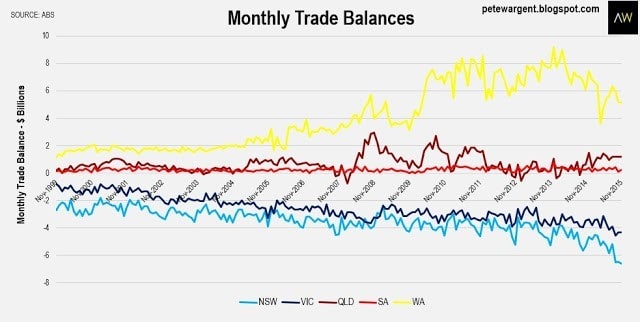Another interesting article was written by the doyen of economic commentary Ross Gittins this weekend, in which he points out that the economy will look better once mining investment stops falling.
The reversion in resources capital investment has long been flagged as a major downside risk for the Australian economy, or even as some kind of economic Armageddon.
Engineering construction activity had declined by about 10 percent in the year to September 2015 to a quarterly value of around $25.4 billion, which is now some 24 per cent down from the peak of $33.6 billion.
Yet as highlighted by Gittins, despite this ongoing contraction the economy managed to grind out GDP growth of 2.5 per cent, helped by net exports and an increase in dwelling construction. Indeed, the non-mining economy grew by about 3 per cent.
I took a more detailed look at the components of GDP growth (and the troublesome decline in the terms of trade) over the year to September 2015.
Mining investment won't fall forever
The good news noted by Gittins is that resources investment cannot continue to decline forever, and sooner or later the nadir will be reached.
Yet as highlighted by Gittins, despite this ongoing contraction the economy managed to grind out GDP growth of 2.5 per cent, helped by net exports and an increase in dwelling construction. Indeed, the non-mining economy grew by about 3 per cent.
I took a more detailed look at the components of GDP growth (and the troublesome decline in the terms of trade) over the year to September 2015.
Mining investment won't fall forever
The good news noted by Gittins is that resources investment cannot continue to decline forever, and sooner or later the nadir will be reached.
The latest available figures showed that the decline was reasonably well advanced by September 2015, although activity still remained well above its "normal" level, particularly in Western Australia and the Northern Territory.

As you can see in the chart above the good news for Queensland is that much of the decline had already taken place by September, with quarterly engineering construction activity declining by 42 per cent year-on-year to just $4.9 billion.
This was a substantial 57 per cent below the September 2013 quarterly peak, when engineering construction activity hit a state record $11.5 billion.
The September 2015 National Accounts showed state final demand (a measure of activity which excludes exports) in Queensland of -0.2 per cent marking a fifth consecutive quarterly decline for the Sunshine State, driven by an ongoing weakness in private gross fixed capital formation (declining non-dwelling construction) as large scale resources projects approached their completion.
This was a significant improvement on the -1.3 per cent decline in Queensland state final demand in the June 2015 quarter, and hearteningly the largest part of the decline in engineering construction activity is now in the rear view mirror.
This was a significant improvement on the -1.3 per cent decline in Queensland state final demand in the June 2015 quarter, and hearteningly the largest part of the decline in engineering construction activity is now in the rear view mirror.
A great challenge for Western Australia (where quarterly engineering construction activity is still highly elevated at $10.3 billion) and the Northern Territory (miles above historic norms at $2 billion, due to the massive Inpex Ichthys LNG project), however, is that the great bulk of the decline in construction activity has yet to take place.
Trade balance improving
It is worth noting that decline in resources construction is not in itself a bad thing: after all the whole point of constructing mining and resources projects is that they will eventually produce commodity exports (reductio ad absurdum if a decline in construction is a 'bad thing', we should never have partaken in a mining boom in the first instance).
A look at the latest International Trade figures shows that over the past three months Queensland has produced a positive trade balance of $1.2 billion per month, after churning out several negative prints in 2014.
A look at the latest International Trade figures shows that over the past three months Queensland has produced a positive trade balance of $1.2 billion per month, after churning out several negative prints in 2014.
Click to enlarge



